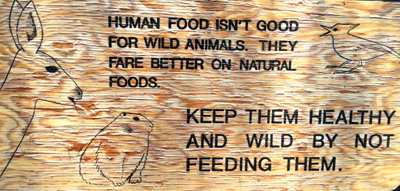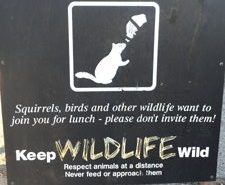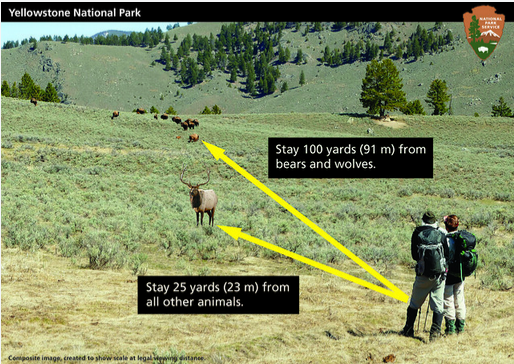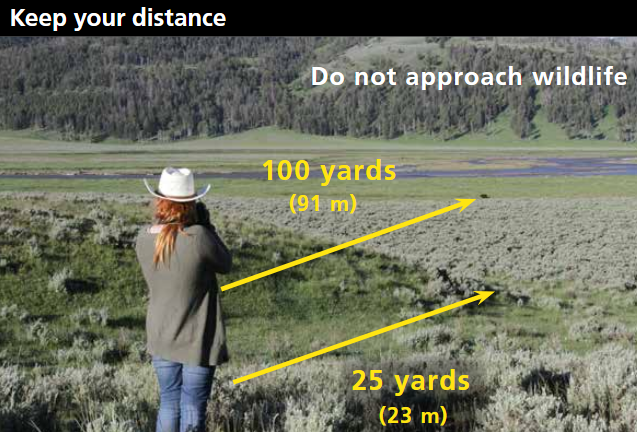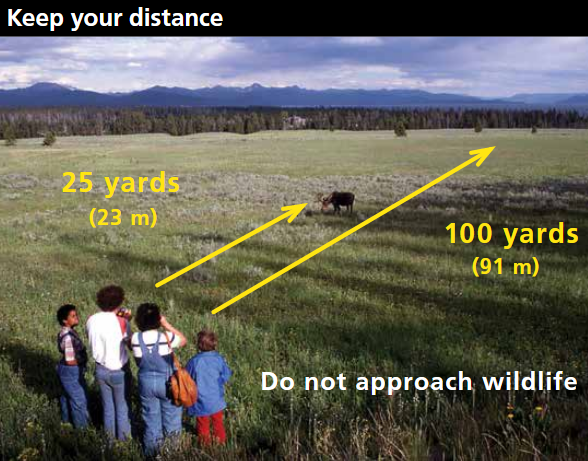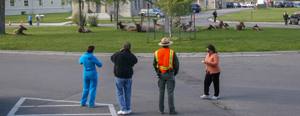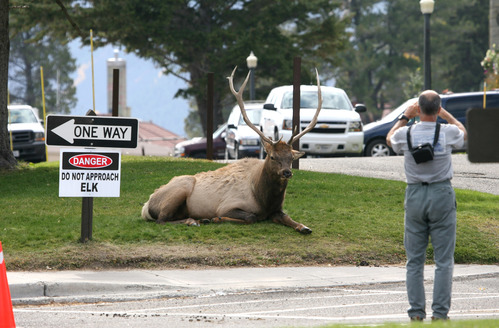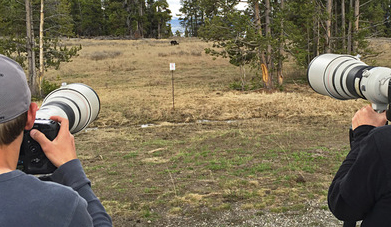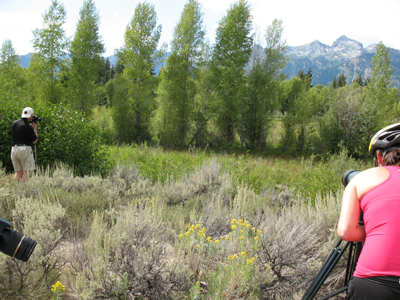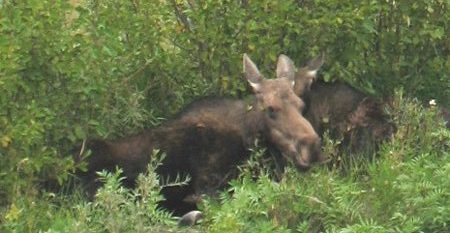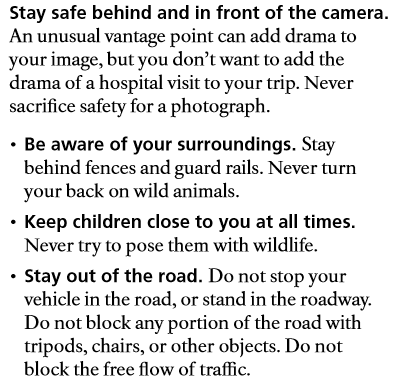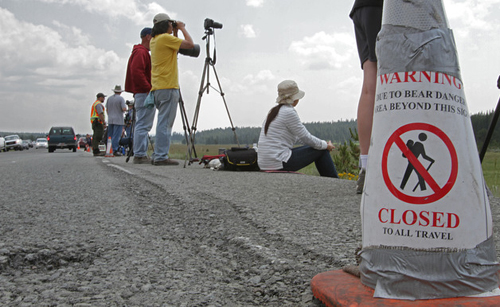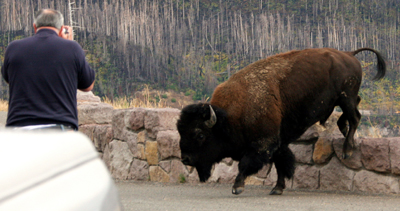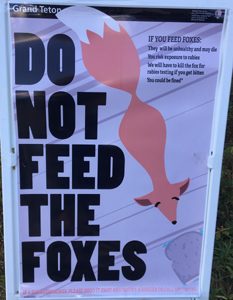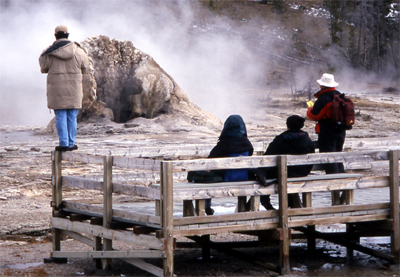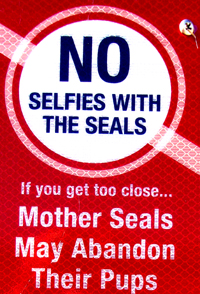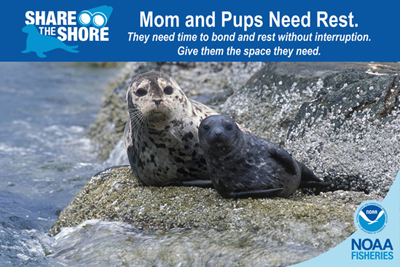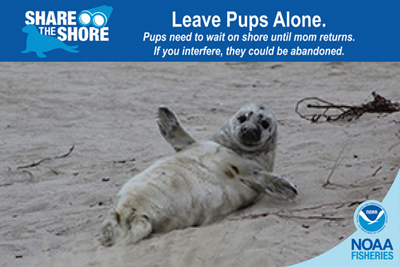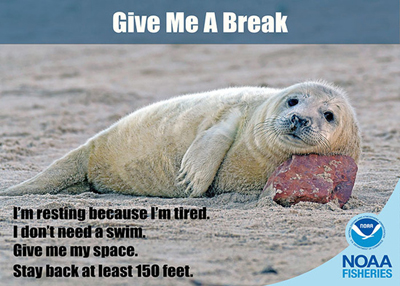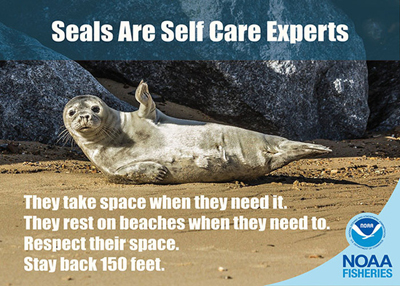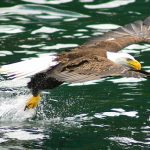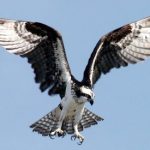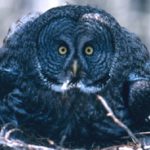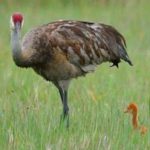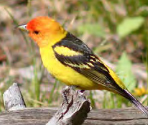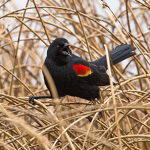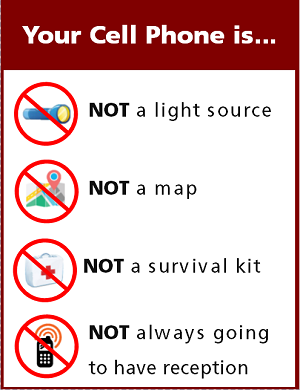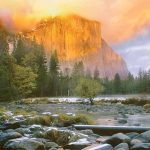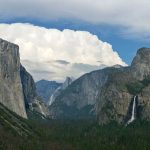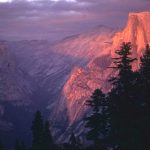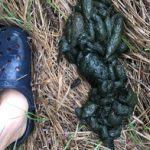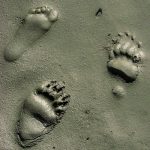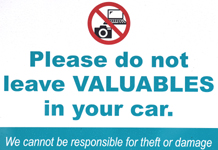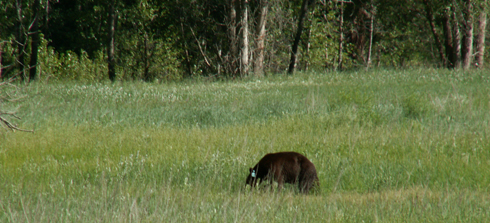This page includes reasons to stay away from even friendly seeming animals in parks
If there’s a group of people, is it safer to be near wildlife?
What if an animal approaches me?
What if an animal begs for food?
(Rocky Mountain National Park has the answers, see near the end of this page).
Below find charts and photos to better be able to determine and visualize how far away from wildlife you need to stay to be safe (and obey laws that do have penalties).
Many National and State park rules say do not approach wildlife,
stay 100 yards (91 m) from bears or wolves
and 25 yards (23 m) from other wildlife including nesting birds and all other large animals, including moose, elk, mountain goat, big-horn sheep, bison, deer, and coyotes.

Keep the animal’s line of travel or escape route clear and move away if wildlife approaches you.
How far away is 100 yards? Picture the length of a football field without the end zones.
25 yards? picture four car lengths or six kayak lengths, or the width of an Olympic-sized pool like ours at the college.
In many national parks, if you have an accidental, surprise or inadvertent closer encounter with wildlife you must remove yourself to those distances, including while driving on a road.
More NPS advice:
“Rule of “thumb”: Another way to help keep your distance is to use the rule of “thumb.” Hold your arm straight and give the animal a thumbs up. If you can’t cover the animal in your line of sight, then you’re too close. Take a few steps back and try again.”
If you are close enough to take a selfie with an animal, you are too close. ”
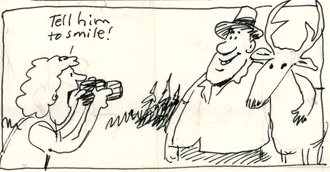
and see They were just taking a selfie. . .
When a bull elk decides to dine at the edge of a road, there might or might not be a park Ranger trying to keep vehicles from stopping / getting out of their vehicle to get that picture too close to the elk.


All is well when the moose is up on a hill, but when he decides to come down, cross the road, and head for his mid-day napping/hiding place, people need to give him a lot more room than these did:
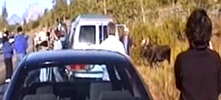
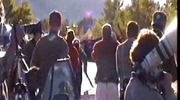
Elk also spend the day in the forest and come down to the flats to eat. When they come across the main highways at dawn or dusk, there may or may not be a park service volunteer directing traffic:
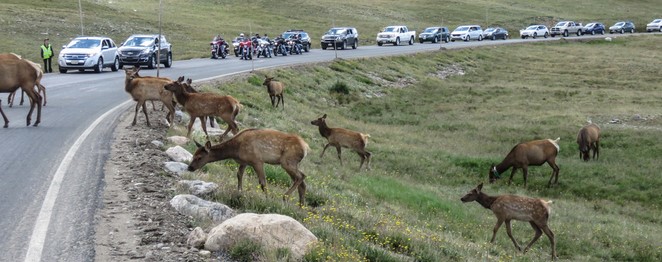
These people out of their car on a highway where a big horn sheep is trying to walk are in danger, even behind those rocks:
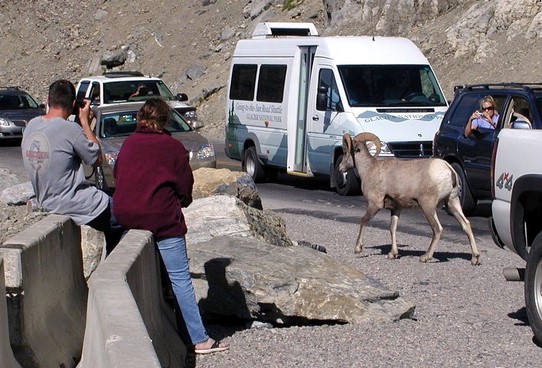
Read about safety at wildlife jams
– – – – – – – – – – – – – – – – – – – – – – – – – – – – – – – – – – – – – – – – – – – – – – – – – – – – – – – – – –
The National Park Service says:
“See something, say something. Tell a ranger if you come into physical contact with wildlife. Also, tell a ranger if you see wildlife that are sick, dead, or acting strangely, including wildlife that approach you. And when you see people who aren’t following these guidelines, let them know what they can do to be a smart wildlife watcher, too, and contact a ranger if necessary. . .”
“Wildlife can be dangerous for your pets. Large animals like moose can trample anything underfoot, and some birds can even fly off with small pets in their talons. Pets look like prey to many wildlife, so they will act accordingly, giving chase and possibly killing your pet, even when on a leash.”
– – – – – – – – – – – – – – – – – – – – – – – – – – – – – – – – – – – – – – – – – – – – – – – – – – – – – – – – – –
Parks Canada warns,
along with keeping a proper distance from animals :
“If you spot the following defensive warning signals, pull back even more or leave the area:
Bears make a ‘woofing’ noise, growl and snap their jaws;
Bull elk and moose put their heads down and paw at the ground;
Cow elk flatten their ears, stare directly at you and raise their rump hair.
If you cause an animal to move, you are too close.”
This NPS photo came with this warning:
“when a moose is stressed it will lay its ears back along its head and its hackles will rise.”
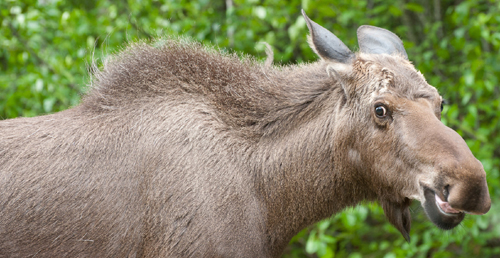
• Denali National park warns: “Moose are not predatory, and they will not try to eat you.
Instead, they try to trample a perceived threat.”
– – – – – – – – – – – – – – – – – – – – – – – – – – – – – – – – – – – – – – – – – – – – – – – – – – – – – – – – – –

Watch a Yellowstone National Park video of mama bear trying to get her cubs through a crowd of people on a bridge:
https://www.nps.gov/yell/learn/photosmultimedia/minute_bearjams.htm
– – – – – – – – – – – – – – – – – – – – – – – – – – – – – – – – – – – – – – – – – – – – – – – – – – – – – – – – – –
Bears on the trail? From the Yosemite Daily report Sept. 20, 2021: “In Yosemite Valley, an elevated number of reports has been received of bears on the Mist Trail. One bear even used the railed steps to come down from the top of Vernal Falls during the middle of the day. If you run into bears on trails, give the animal plenty of space and protect your food—do not abandon it. Given the many heavily populated, narrow, switchbacking trails in the park – it is easy for a bear to quickly become surrounded with no exit if it is not given proper space. Always try to maintain 50 yards from a bear, even if that means backtracking and waiting for the bear to pass. If the bear approaches you (closer than 50 yards) yell as loudly as possible and try to scare the bear off…”
This is also quoted at: Hiking Advice, which has has HIKING SECRETS and etiquette including hiking in the heat, preventing and/or dealing with blisters, logistics of hiking, a day hike gear list, winter hiking and the answer to the question: When is the best time of day to cross a mountain stream?
– – – – – – – – – – – – – – – – – – – – – – – – – – – – – – – – – – – – – – – – – – – – – – – – – – – – – – – – – –
Rangers often patrol (but can not be there all the time) at areas like Mammoth in Yellowstone, because elk are often in the vicinity of people:
and because, even with
warning handouts given to people as they enter the park,
warnings when checking into hotel rooms / campgrounds,
and warning signs,
photographers get too close.
Yes, you might need to wait awhile to get into your car:
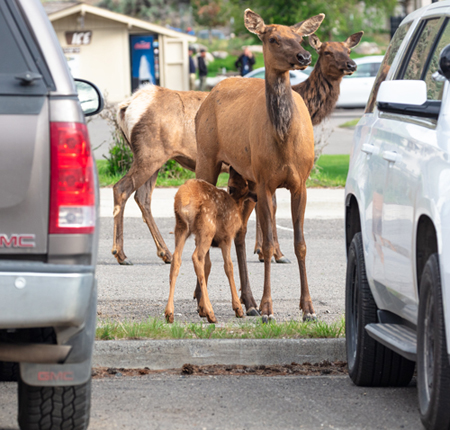
Everyone who was taped in this one-minute duration National Park Service video
should have been getting far away from these elk,
not staying to watch or photograph (even hiding between their cars):
( Yellowstone Park notes: “The antlers of a typical, healthy bull are 55–60 inches long, just under six feet wide, and weigh about 30 pounds per pair.”)
See Rocky Mountain Mammal Size Comparisons for more.
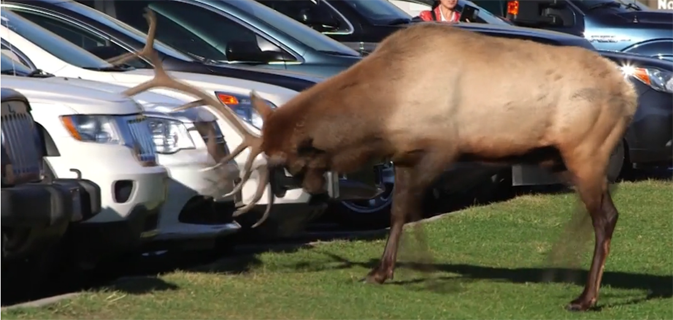
Photographers need telephoto lenses to get the great photo from the distances away from animals that parks require by law. Can you spot the dot (grizzly bear) at the center near the top of the photo below?
You can stay far enough away from animals if you have a telephoto lens for your camera,
and get a photo of animals other people won’t even be able to see:
Some areas known for attracting photographers to see animals will have signage, for example, the poster duct-taped on this pylon
“WARNING, Due to bear danger area beyond this sign CLOSED to all travel.”
– – – – – – – – – – – – – – – – – – – – – – – – – – – – – – – – – – – – – – – – – – – – – – – – – – – – – – – – – –
from a Yellowstone report:
“Despite their size and seemingly slow moving habits, bison are surprisingly agile and can be quick to react.”
This photographer might have thought he was far enough away because he had a wall between him and the bison, but bison (1,000 to 2,000 pounds) are capable of hopping quickly over walls:
Before bison charges has more, including what people were doing before a bison charged them, and injuries they received.
– – – – – – – – – – – – – – – – – – – – – – – – – – – – – – – – – – – – – – – – – – – – – – – – – – – – – – – – – –
At a stop to get takeout food at the Jackson Lake Lodge in Grand Teton National park, we saw people in a group. This usually means either a tour bus group, or … moose in the parking lot.

The children in the picture above were allowed to get much too close.
The juvenile moose became separated from mom and then got nervous and ran back.

– – – – – – – – – – – – – – – – – – – – – – – – – – – – – – – – – – – – – – – – – – – – – – – – – – – – – – – – – –
Rocky Mountain national park had this advice::
What if I want to get an animal’s attention?
Calling, clicking, whistling or making noises of any kind to attract wildlife is illegal. Animals deserve to enjoy the park without disruption just as you do.
If there’s a group of people, is it safer to be near wildlife?
Traveling in groups can help keep you safe, but that does not mean you are safer to get closer to animals. Whether it’s just you or 20 people, keep the long distance. As crowds gather (as they often do), wildlife can quickly feel threatened and, in their panic, harm people. This is especially the case as people start to surround the animal(s), even if they are at the proper distance, because the wildlife may feel trapped. If people around you stop maintaining the safe distance, don’t be afraid to speak up and remind your fellow visitors of the safe distance rules. Sometimes, in the moment, anyone could use a gentle reminder that long-distance relationships with wildlife are better for everyone.
What if an animal approaches me?
Wildlife may not know better, but YOU do. Although it may feel flattering, if any kind of wildlife approaches you, back away and maintain that safe distance. It’s your responsibility and your safety—help us keep wildlife wild.
Can I feed the animals?
Perhaps you’ve fed animals in petting zoos before, but national parks are different. Help us keep this place and these animals unique by never feeding them.
Feeding wildlife is prohibited. Even feeding animals grass from the park or other food you think might be harmless is not allowed. This is for their safety as well as yours.
Wildlife will invade food left unattended, even those in bear-proof containers or coolers. Store food in your vehicle’s trunk, out of sight, with the windows completely closed, or in site-provided storage lockers. Use our wildlife-proof containers to dispose trash, and ensure you clean up all food particles.
Food, coolers, and dirty cookware left unattended, even for a short time, are subject to confiscation by park rangers and citations.
(Please note that in Yosemite bears actually break in to vehicles, so the advice above from Rocky Mountain national park to “Store food in your vehicle’s trunk” is not applicable to Yosemite, and could become the wrong thing to do anyplace you might vacation, so check with the park in advance of your trip. See Black Bear Management Trends for many stories about people who did not store food properly, and the warning: “Remember that proper food storage in Yosemite includes being within arms’s reach when your food is not otherwise stored legally . . . Improper food storage may result in impoundment of your food or car, a fine of up to $5,000, and/or revocation of your camping permit.”.)
What if an animal begs for food?
Animals can easily pick up scavenging practices, so never feed them. Animals stay healthier when you do not feed them. And, once they learn to beg, they can become aggressive, more likely to get injured by vehicles, and become seriously ill. They do not need your food handouts to survive. You can help us curtail this unwanted behavior from animals by putting your food away and moving away from the animal. Ask a ranger for other ways you can help.
Ah, but what harm could one person really do when they get too close or toss a piece of food to an animal? I’ve been up close to wildlife before!
Some of us might think of ourselves as “animal whisperers” or be really familiar with certain kinds. We can certainly appreciate that, but consider using your gift to help our national parks be a place where wildlife can be wild. That’s why you and all of our other guests have come to appreciate these special places. Be a role model to others in your family or group and even other visitors by embodying our mission to protect and preserve our wildlife.
Risks to you include:
• Bites, scratches, and/or bruises
• Infectious diseases
• Internet/media fame for a very undesirable reason (Have you seen the number of YouTube videos and news reports of people getting attacked by wild animals because they got too close?)
• Damage to your vehicle or belongings
• Animal waste in or on your belongings (or you) when you do not secure and store your food properly
• Pesky and persistent animals that could become aggressive
• In rare cases, severe injuries or even death
Risks to wildlife include:
• Diseases
• Poor health
• Increased likelihood of being killed by vehicle traffic because they are drawn to visitor areas
• Euthanasia when animals become aggressive or harmful to visitors
• Injuries
• Young wildlife may be abandoned
photographers too close to a bear:


– – – – – – – – – – – – – – – – – – – – – – – – – – – – – – – – – – – – – – – – – – – – – – – – – – – – – – – – – –
This sign above in Grand Teton National park campgrounds details what can happen if you decide to feed the foxes that are all over the area:
DO NOT FEED THE FOXES
If you feed foxes:
They will be unhealthy and may die.
You risk exposure to rabies.
We will have to kill the fox for rabies testing if you get bitten.
You could be fined.
Yellowstone Park has this advice: “Your Safety in Wolf Country
Wolves are not normally a danger to humans, unless humans habituate them by providing them with food. No wolf has attacked a human in Yellowstone, but a few attacks have occurred in other places.
Like coyotes, wolves can quickly learn to associate campgrounds, picnic areas, and roads with food. This can lead to aggressive behavior toward humans.
What You Can Do
• Never feed a wolf or any other wildlife. Do not leave food or garbage outside unattended. Make sure the door is shut on a garbage can or dumpster after you deposit a bag of trash.
• Treat wolves with the same respect you give any other wild animal. If you see a wolf, do not approach it.
• Never leave small children unattended.
• If you have a dog, keep it leashed.
• If you are concerned about a wolf—it’s too close, or is not showing sufficient fear of humans— do not run. Stop, stand tall, and watch what the wolf does. If it approaches, wave your arms, yell, flare your jacket. If it continues, throw something at it or use bear pepper spray. Group up with other people, and continue waving and yelling.
• Report the presence of wolves near developed areas or any wolf behaving strangely.
To date, eight wolves in Yellowstone National Park have become habituated to humans. Biologists successfully conducted aversive conditioning on some of them to discourage being close to humans, but two had to be killed.
. . . If you are concerned about a wolf — it’s too close, or is not showing sufficient fear of humans — do not run. Stop, stand tall, and watch what the wolf does. If it approaches, wave your arms, yell, flare your jacket. If it continues, throw something at it or use bear pepper spray. Group up with other people, and continue waving and yelling.”
Please watch this video provided by Yellowstone park:

And see: Wolf pack territories in Grand Teton and Yellowstone National Parks (surveys / charts / maps of the territories of wolf packs for many years) and wolf watching tips, with photos and drawings showing the size comparison of a wolf, coyote and a fox.
– – – – – – – – – – – – – – – – – – – – – – – – – – – – – – – – – – – – – – – – – – – – – – – – – – – – – – – – – –
This man is not only risking serious injuries if he falls into the near-boiling point water at this Yellowstone geyser,
he is also a role-model for any kids watching who think they can do what he is doing:
![]()
 Was that a black bear or a grizzly, a coyote or a wolf or a fox we just saw?
Was that a black bear or a grizzly, a coyote or a wolf or a fox we just saw?
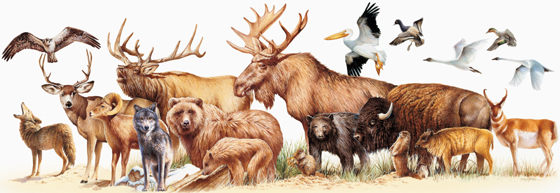 Rocky Mountain mammal size comparisons has photos and comparisons of beavers, squirrels, pika, marmot, elk, moose, bison, fox, coyote, wolf, golden-mantled ground squirrel, chipmunk, Red Squirrel (also known as) Chickaree, Unita Ground squirrels, bobcat, lynx, mountain lion (cougar), pine marten, mountain goats, bighorn sheep, pronghorn, grizzly and black bears, tundra swan, trumpeter swan, adult and juvenile Bald Eagles.
Rocky Mountain mammal size comparisons has photos and comparisons of beavers, squirrels, pika, marmot, elk, moose, bison, fox, coyote, wolf, golden-mantled ground squirrel, chipmunk, Red Squirrel (also known as) Chickaree, Unita Ground squirrels, bobcat, lynx, mountain lion (cougar), pine marten, mountain goats, bighorn sheep, pronghorn, grizzly and black bears, tundra swan, trumpeter swan, adult and juvenile Bald Eagles.
___________________________________
Grand Teton National Park birds has photos and details about the most common ones we can hope to see
including Bald Eagle, Red-winged Blackbird, Canada Geese, Clark’s Nutcracker, Golden Eagle, Great Blue Heron. Great Gray Owl, Harlequin duck, Loon, Magpie, Merganser, Northern Flicker (woodpecker), Osprey, Ouzel, Pelican, Peregrine Falcon, Ptarmigan, Raven, Sandhill Cranes, Steller’s Jays, Trumpeter Swan , Western Meadowlark, and Western Tanager, with links to calls / songs from most of them to listen to.
and you can Download photos of over a hundred birds of Grand Teton National Park
https://www.audubon.org/climate/national-parks/grand-teton-national-park
___________________________________
your safety in grizzly bear territory tells you what to do if you see a grizzly in the distance or if a bear charges you and has info about Bear Pepper Sprays.
__________________________________________
![]()
Top reasons to not speed in a National Park has defensive driving advice.
__________________________________________
How to not collide with a deer,
fatal, near fatal or close call incidents/accidents in camping, backpacking, climbing and mountaineering is a collection of some of the true stories I use in my wilderness first aid class to illustrate how the wilderness is not dangerous, it’s the people who aren’t prepared, who don’t know what they are doing, or who take inordinate risks, that are the danger.
Cell phones in the wilderness has advice on how/when to use a cell phone to contact 911 in the wilderness and a warning about interference between cell phones, iPods and avalanche beacons.
Thunderstorm and lightning safety includes a warning about not using your cell phone or IPod during a storm.
Yosemite National Park regulations, policies and rules links
Parking and traffic jams in Yosemite valley tips and tricks
Prepare for winter driving has a link to bad weather driving tips, tips for using tire chains, tricks for dealing with frozen car locks, how to prepare your vehicle for winter driving, how to de-fog the windows, a winter survival kit for your car and what to do if you get stranded
Road trip advice and etiquette has ideas for limiting boredom, getting along on a road trip and some packing and safety tips.
Where were they when they got that great picture in Yosemite?
Where can I take a photo that looks like the one on a Yosemite postcard I just bought?
Places to take photos of Half Dome, Bridalveil Fall, El Capitan, Yosemite Falls and Staircase Falls.
___________________________________
See also: animal sign comparisons
(how to use tracks and scat to distinguish species)
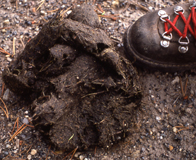
Please do not handle scat. Wolf scat, for example, can transmit tapeworm eggs to humans.
___________________________________
This warning from Canada can apply to any long-distance drive: “Visitors to large cities and popular tourist destinations should be aware that parked cars are regularly targeted for opportunistic smash-and-grab thefts, and they are cautioned to avoid leaving any unattended possessions in a vehicle, even in the trunk. Due to the high incidence of such crimes, motorists in Montreal, Toronto, Vancouver and some other jurisdictions can be fined for leaving their car doors unlocked or for leaving valuables in view. Visitors should exercise precaution to safeguard their property.”
– – – – – – – – – – – – – – – – – – – – – – – – – – – – – – – – – – – – – – – – – – – – – – – – – – – – – – – – – –

The Yosemite National Park rangers would like you to call them
if you see a bear in Yosemite,
no matter where it is or what it is doing.
Since 2003 there has been a note in the Yosemite Guide: “REPORT ALL BEAR SIGHTINGS! To report bear sightings, improper food storage, trash problems, and other bear-related problems, leave a message for the Bear Management team at: 1 (209) 372-0322. Your call can be made anonymously.”
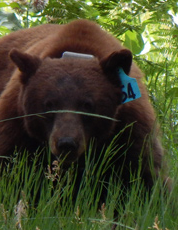
If you can, in all the excitement, try to notice if the bear has a tag (usually on the ear), the color of the tag and if possible, the number on it (the tag is large enough that with a telephoto lens you should be able to read the number).
From the Yosemite Daily Report newspaper:
“It is extremely important to remember to yell at bears that are in and around development, even if they are foraging on natural food. Though it is very tempting to get close for a picture, or just to watch these incredible animals, it is important not to give into this urge. Yelling at them if they are in residential areas or near people is critical to keep bears natural fear of humans. Giving bears plenty of space. When bears become too comfortable around people, they will often start causing damage to structures and vehicles, or will even become too bold around people, creating safety concerns.”
And the Yosemite Daily Report also said:
“Scare bears when you see them. . . in developed areas- Yell like you mean it!
Make as much noise as possible, try waving your arms, stomping your feet
or anything to make you look intimidating and to get the bear to run away.
We know it’s fun to see bears and it can feel mean to scare them,
but this is a simple way to truly help save a bear’s life.”



The author of this webpage, (written as a homework reading assignment for my students), does not give any warranty, expressed or implied, nor assume any legal liability or responsibility for the accuracy, completeness, or usefulness of any information, product, or process included in this website or at websites linked to or from it. Users of information from this website assume all liability arising from such use.
